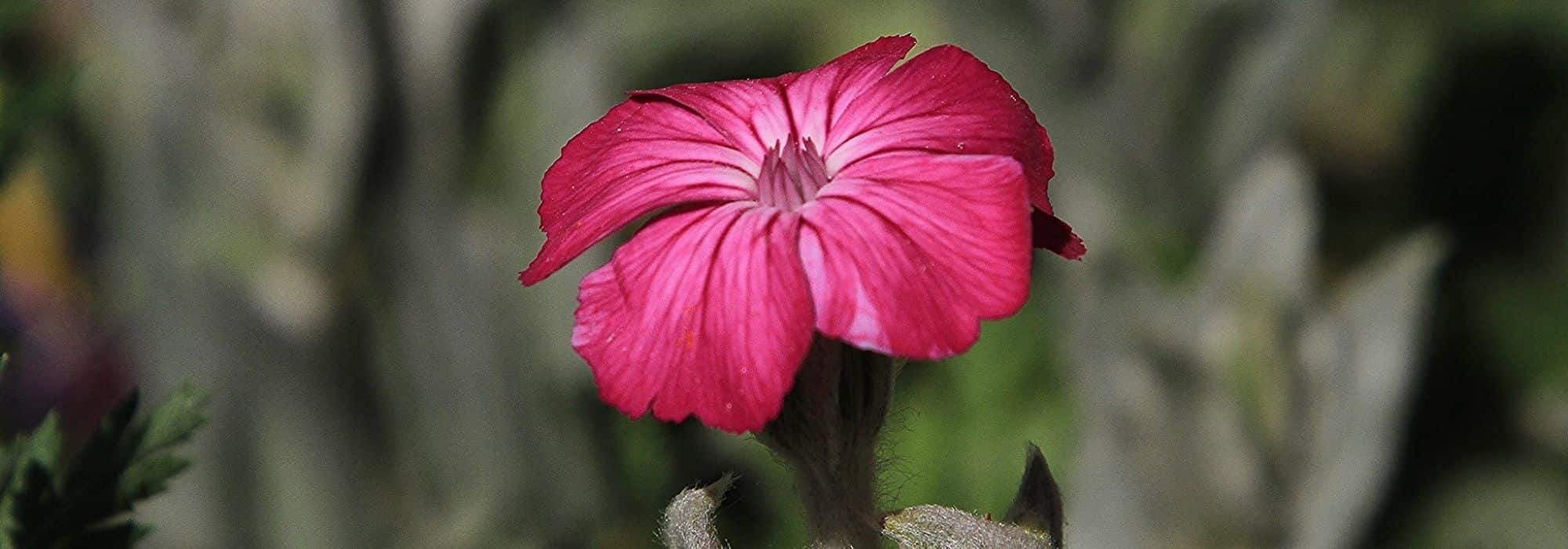
How to pair lychnis?
Our inspirations for showcasing lychnis in your garden
Contents
Beautiful perennials with grey or green foliage, Lychnis are easy to grow and adaptable to many situations, depending on the varieties. The Red Campion or Garden Lychnis (Lychnis coronaria) prefers dry soils, while the Ragged Robin (Lychnis flos-cuculi) thrives by the water’s edge. As for the Catchfly (Lychnis viscaria) with its abundant flowering and the Jerusalem Cross (Lychnis chalcedonia), they favour cool soils, whereas the Alpine Lychnis (Lychnis alpina) does well in rockeries. In short, all flower enthusiasts can invite Lychnis into their gardens, which will surely find their place in a natural, slightly wild border, or deliberately romantic, a lush edge, a dry rockery, or by a pond. Discover our 5 suggestions to make the most of the beauty of Lychnis.
And with our Planfit web application, check which Lychnis is best suited to your geographical area, the sunlight in your garden, or the nature of your soil.
A flowerbed in a romantic garden
With its light and abundant flowering and the soft colours of its flowers, often in shades of pink and white, lychnis is ideal for a border with gentle romantic accentss. Lychnis offers all shades of pink, from very pale to deeper pink, as well as touches of white with the Lychnis coronaria ‘Alba’. The magnificent Lychnis coronaria ‘Angel’s Blush’ with its large angelic flowers in shades of white and pink will also look stunning when paired with ‘Pacific Galahad’ delphiniums with their enormous white blooms, Buenos Aires verbenas (Verbena bonariensis ’Cloud’) with their delicate flowering, or light hardy geraniums like hardy geranium Dilys. The ‘Gallery White’ lupin will add the finishing touch to your romantic border with its beautiful white flowers and graphic foliage.
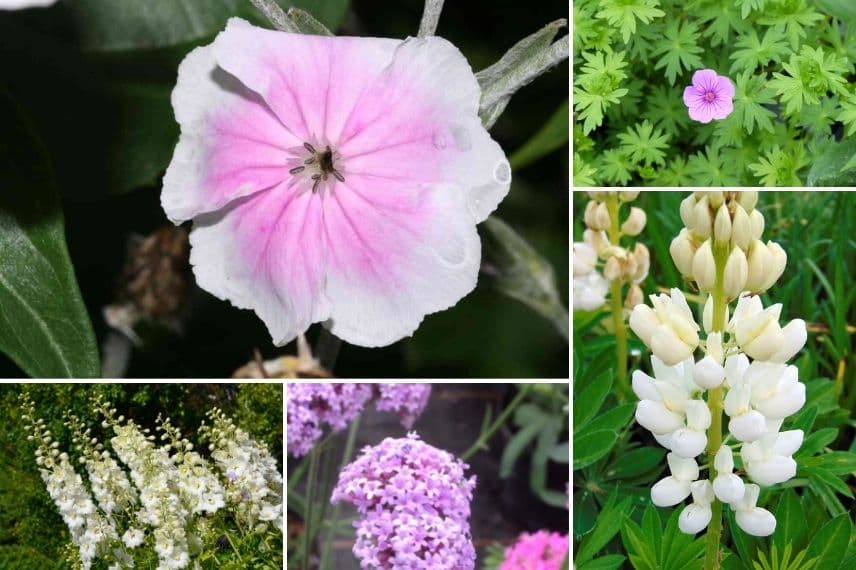
Lychnis coronaria ‘Angel’s Blush’, hardy geranium ‘Dilys’, Delphinium ‘Pacific Galahad’, Verbena bonariensis ‘Cloud’ and lupin ‘Gallery White’
In a naturalistic border
In a naturalistic garden, the plantings have a natural appearance, yet are skillfully controlled. Heavily inspired by flowering meadows, naturalistic beds play on abundance, the wild aspect of certain perennials, harmoniously mixed with a few grasses and more aromatic plants to attract pollinating insects.
Lychnis therefore has its place here, particularly the Garden Catchfly (Lychnis coronaria) and the Viscaria (Lychnis viscaria), which form clusters of bright flowers in spring. You can choose Lychnis viscaria ‘Plena’ with double flowers of intense pink perched on slender stems, or Lychnis coronaria ‘Gardener’s World’, bushy and covered in magenta flowers. To this base, add Origanum laevigatum ‘Herrenhausen’ for fragrance, echinaceas, sages (Salvia nemerosa), foxgloves, phlox, and silene with flowering that extends from June to August. All that remains is to complete your naturalistic tableau with grasses such as carex, fescues, or stipas.
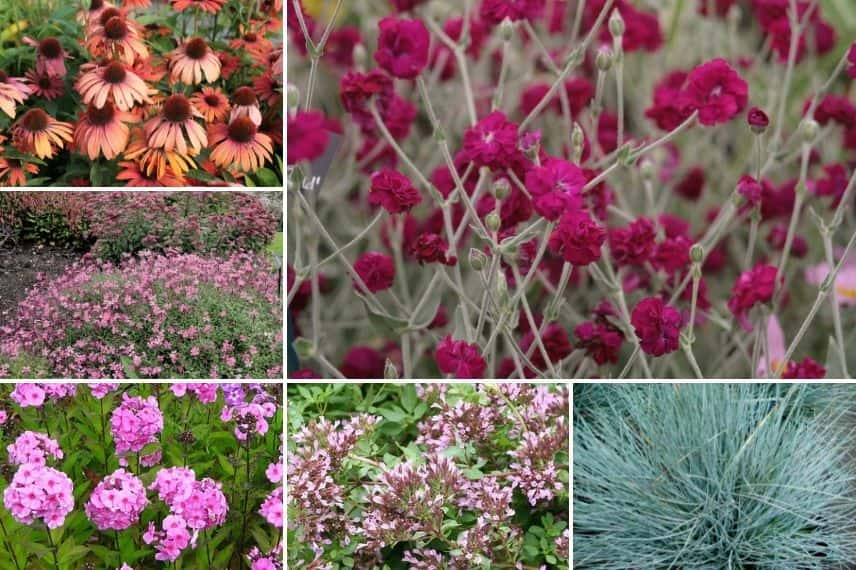
Echinacea ‘Julia’, Lychnis coronaria ‘Gardener’s World’, Silene schafta, Phlox paniculata ‘Eva Cullum’, Origanum laevigatum ‘Herrenhausen’ and blue fescue
Discover other Lychnis
View all →Available in 0 sizes
Available in 0 sizes
Available in 2 sizes
Available in 1 sizes
Available in 2 sizes
Available in 2 sizes
Available in 1 sizes
Available in 2 sizes
Available in 1 sizes
Available in 2 sizes
For a water's edge.
Mere, pond, artificial basin, fountain… Whatever the water feature, the surrounding vegetation adds an aesthetic touch. However, it is not always easy to find plants suited to these moist soils. The Lychnis flos-cuculis or cuckoo flower is perfectly adapted to rich, moist beds in sunny locations. For example, Lychnis flos-cuculis ‘White Robin’, paired with Camassia leichtlinii ‘Sacajawea’, will be enhanced by the variegated foliage of Astilbe arendsii ‘Colour Flash’, or that of a fern such as Osmunda claytoniana, which particularly enjoys waterside locations. Add a plant of Filipendula ulmaria ‘Variegata’ or meadowsweet for its airy quality, and punctuate your decor with a splash of yellow from a Caltha palustris var. alba. Planting a hosta will complete the picture.

Clayton’s Osmunda, Lychnis flos-cuculis ‘White Robin’, Caltha palustris ‘Alba’, Camassia sacajewa, Filipendula ulmaria ‘Variegata’ and Hosta undulata var. univittata
Read also
How to choose a Lychnis?For an alpine rockery
Lychnis alpina or Alpine Lychnis is a perennial ideal for greening a rockery, a low wall or paving stones. It forms a bushy clump 15 to 20 cm high and is covered with small pink flowers. However, it requires cool soil as it is an alpine perennial. You can easily combine it with aubrietes, white or mauve, wall campanulas, Arabis or basket of silver, pulsatillas, and saxifrages that will adapt to the same growing conditions as Alpine Lychnis. Very quickly, all these perennials will settle into a crevice of a wall; they require little soil and self-seed quite easily. Don’t hesitate to add Lewisia cotyledon which does not fear winter moisture.

Lychnis alpina, Pulsatilla vulgaris ‘Violet’, Saxifraga x arendsii ‘Pixie’, Aubrieta ‘Cascade blue’, Arabis caucasica ‘Snowcap’ and Lewisia cotyledon
In a dry garden border
Having gained popularity in recent years, the dry garden is being designed in a Mediterranean climate, but also elsewhere. Ideal as it requires little watering and is perfectly suited to poor soils that retain little water, this type of garden or simple border, largely exposed to the sun, will withstand climate changes and summer droughts. The Garden Campion (Lychnis coronaria) can easily join this type of border. You can pair it with beautiful clumps of lavender or perennial potentillas that bloom abundantly throughout the summer. In the foreground, helianthemums will offer their delicately crumpled flowers, while achilleas and Nepetas will add a natural touch. As for the silvery grey foliage of Santolina chamaecyparissus, it will echo that of the Garden Campion.

Lychnis coronaria ‘Atrosanguinea’, Santolina chamaecyparissus argentée, Achillea millefolium ‘Schneetaler’, Helianthemum ‘The Bride’ and Potentilla atrosanguinea
- Subscribe!
- Contents
![[lychnis-partner] lychnis-associer](https://www.promessedefleurs.ie/blogwp/wp-content/uploads/2022/01/lychnis-associer.jpg)































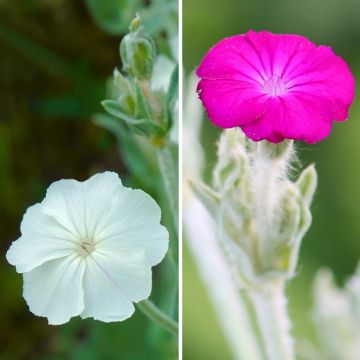

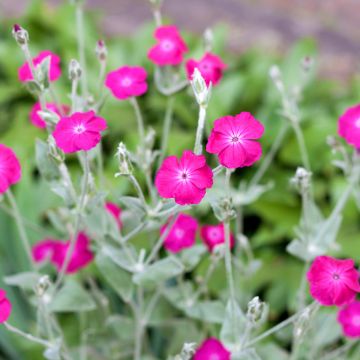

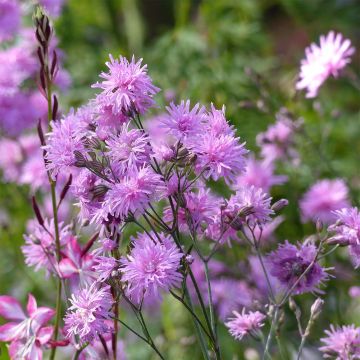
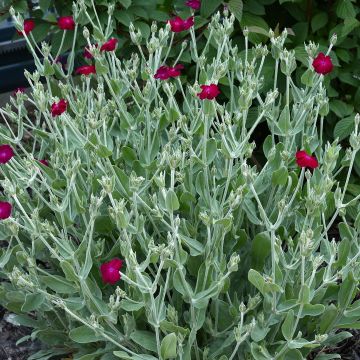
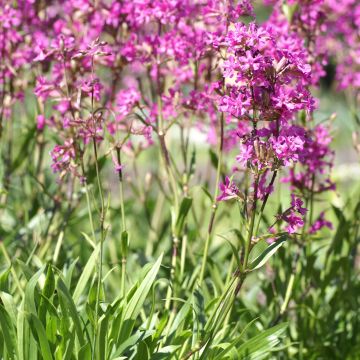

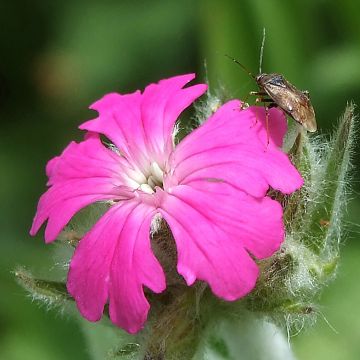

Comments